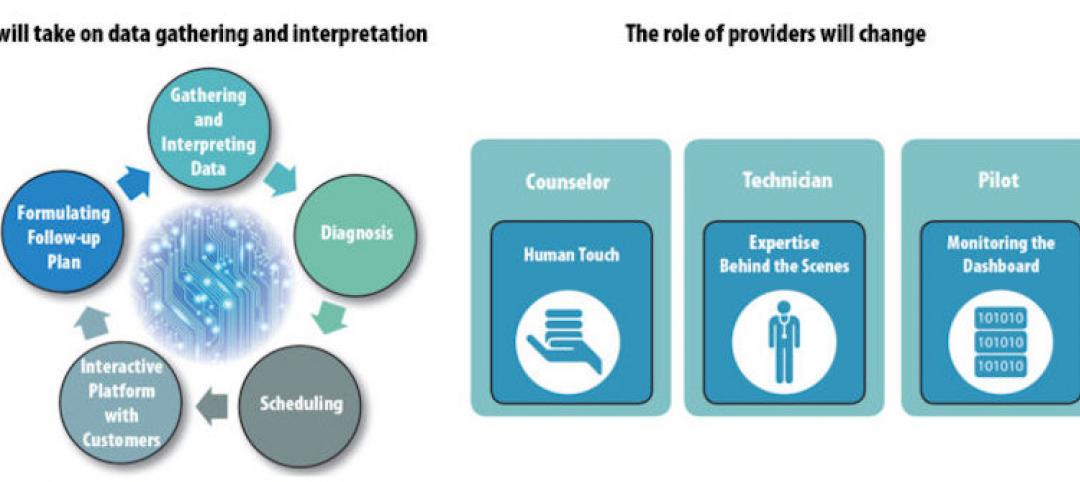 |
|
40 Solatube devices (square in celing) and a central spine of skylight near the entire second floor of the Champaign Public Library. |
The new public library in Champaign, Ill., is drawing 2,100 patrons a day, up from 1,600 in 2007. The 122,600-sf facility, which opened in January 2008, certainly benefits from amenities that the old 40,000-sf library didn't have—electronic check-in and check-out, new computers, an onsite coffeehouse. But, it's also drawing rave reviews from the community for its full-building daylighting strategy.
“We're one of the busiest libraries in the nation,” says library director Marsha Grove. “In 2008 we checked out 2.5 million books, and a lot of the comments we hear from patrons say they like all the sunlight in the new building.”
Chicago architect Carol Ross Barney was tasked by the library board with designing a building that would last 100 years. The old CPL had been built in the late '70s and simply didn't age well. Ross Barney's design included clerestory windows and a 115-foot skylight over the central staircase to let the sun shine in. But she also specified tubed daylighting devices instead of ceiling lights in much of the building's second story. The devices, manufactured by Solatube, Vista, Calif., have a plastic-domed, circular opening on the roof that allows natural light to travel down through a mirrored metal tube, through the plenum, and into a diffuser in the ceiling. From there, the light spreads out to the room below.
 |
|
Solatube's Raybender 3000 technology intercepts low-angle light and redirects it down the tube at a steep angle so less light is lost and light is transmitted at almost any time of the day. |
“We always wanted to make the library capable of being fully daylit,” says Ross Barney. “We made one concept where it had a really narrow plate of about 60 feet. Because of the space needs of the library, though, we couldn't make that design work. It was very different than what is thought of as a library.” The daylighting devices, she said, “allowed us to make a more beautiful building. The lighting really is striking.”
Most of the library is lit during the day by the devices and the central skylight. The building is organized on two patron levels; administration offices on the third floor cover only a small portion of the second-floor roof. Glass curtain wall covers three sides of the library. Local general contractor PKD installed 40 of the tubed daylighting devices on the second-floor roof to deliver light directly to the main reading areas of the library. Lighting levels are controlled by an automated sensing system that balances the natural light with supplied light. Panelite glass in the south curtain wall is designed in a honeycomb pattern that reflects most of the direct sunlight that enters the building from the south to minimize solar heat gain.
Public spaces in the LEED Silver-certified library are served by a low-velocity displacement HVAC system with underfloor air distribution to save energy. The building's exterior is clad in limestone. Bamboo was used for flooring, wall, and ceiling finishes. Service desks, end panels, and other interior furnishings are also crafted from bamboo and limestone.
Ross Barney says the building was purposely sited so that the parking lot could someday be converted to a park. “It's all a part of the strategy to make a building that's not just designed for today, but for tomorrow as well,” she says.
Related Stories
Building Technology | Apr 21, 2017
AIA selects 2016 Upjohn Research Initiative Projects
Grants awarded to initiatives that study various aspects of design within the built environment.
Building Technology | Mar 9, 2017
Prefabrication's predicament: It's much harder than it looks
Many of the nation’s largest contractors, including Gilbane, Mortensen, Skanska, and Turner, have been utilizing prefab techniques on select projects for a decade or more.
Great Solutions | Mar 8, 2017
Pop-out balcony is a breath of fresh air for stuffy hotel rooms and apartments
In less than one minute, Bloomframe transforms from an insulated picture window to an open balcony.
Building Materials | Feb 15, 2017
New metamaterial cools roofs without any energy consumption
The material is barely thicker than aluminum foil and can be economically manufactured for large-scale residential and commercial applications.
Building Technology | Feb 13, 2017
Denver’s ‘smart neighborhood’ will be packed with futuristic technology
The neighborhood will become a test lab for innovative technology.
Virtual Reality | Feb 1, 2017
Tour ancient buildings and cities as they were when new with Lithodomos VR
An Australian archeological startup is bringing the ancient world to a VR headset near you.
Building Technology | Jan 30, 2017
Machine learning could help buildings notify occupants about critical systems failures before they happen
Data from sensors built into HVAC units paired with a machine learning algorithm predicted 76 out of 124 real faults for an Italian hospital.
Building Technology | Jan 27, 2017
The driverless clinic: How buildings powered by AI can help promote wellness and enhance human connections
In the future, we envision that the smart technology in our phones will be embedded in the items we wear and the objects we use.
Building Technology | Jan 24, 2017
A U.S. startup is working with Dubai to advance 3D printing for construction
Cazza Construction Technologies is building a crane that it claims can layer more than 2,000 sf of concrete per day.
Energy Efficiency | Jan 5, 2017
Exponential growth in net zero energy buildings predicted for the next two decades
Technology and regulations will be the drivers, says Navigant Research.















